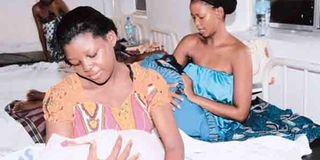How to cut maternal, child mortality

Mothers look after their newborn babies at a hospital. A new study suggests that provision of adequate contraceptive and maternal and newborn care will reduce annual maternal deaths from 308,000 to 84,000 and newborn deaths from 2.7 million to 541,000. PHOTO | FILE
What you need to know:
- A global study on contraception and maternal health published by the US-based Guttmacher Institute shows that maternal and newborn deaths can be reduced by critically investing in both contraceptive and maternal health services.
Dar es Salaam. Tanzania and other developing countries need to invest less than $8.39 (about Sh18,778.50) per person a year to reduce maternal and newborn deaths, a new study suggests.
A global study on contraception and maternal health published by the US-based Guttmacher Institute shows that maternal and newborn deaths can be reduced by critically investing in both contraceptive and maternal health services.
Dr Ann Biddlecom, Director of International Research at the Guttmacher Institute, and co-author of the study, said during a media tele-briefing on Wednesday that providing contraception and maternal and newborn care to all in need would cost $8.39 (about Sh18,778.50) per person per year in developing countries. “This will result in 67 million fewer unintended pregnancies, 23 million fewer unplanned births, 36 million fewer abortions, 2.2 million fewer newborn deaths and 224,000 fewer maternal deaths,” said Dr Biddlecom.
The 2015-2016 Tanzania Demographic and Health Survey shows that 30 women die every day due to pregnancy related complications and 180 newborns die every day during birth. About 27 per cent of adolescents are either mothers or are pregnant with their first child at the age of 19, while 1 out of 5 women have no access to family planning services.
A 2013 study by researchers at the Guttmacher Institute and the National Institute for Medical Research and the Muhimbili University of Health and Allied Sciences found that about 405,000 abortions were performed in the country in 2013. The majority of abortions were clandestine procedures that put women at risk of death and injury. Abortion is said to be a major maternal death threat in the country.
“In 2013, Tanzanian women had just over one million unintended pregnancies, 39 per cent of which ended in abortion.
Addressing the un-met need for contraception will reduce the incidence of unintended pregnancy and thereby the need for abortion, deaths and injuries that often follow unsafe procedures,” Ms Colette Rose, Senior International Communications Manager for Guttmacher Institute told The Citizen.
The study titled ‘Adding it Up: Investing in Contraception and Maternal and Newborn Health 2017’, which was launched yesterday shows that every additional $1 (about Sh2,238.20) spent on contraceptive care saves $2.30 (Sh5,147.86) on maternal and newborn care due to declines in unintended pregnancies. About 308,000 women in developing countries will die from pregnancy-related causes in 2017 and 2.7 million babies will die in the first month of life, the study reveals.
Most of these deaths, the study says could be prevented with full access to contraceptive care to help women avoid unintended pregnancies and maternal and newborn health care to help mothers and newborns through pregnancy and delivery.
Dr Biddlecom said 214 million women aged 15-49 in developing countries, who wanted to avoid pregnancy were not using modern methods of contraception, while tens of millions more were unable to access basic pregnancy and delivery care they needed to protect their own health and that of their new born babies. She said only 1 in 3 women experiencing complications during pregnancy or delivery received the care they or their newborns needed.
The study suggests that giving these women access to modern contraceptives will reduce unintended pregnancies, unplanned births and induced abortions by 75 per cent. The findings also show that providing full contraceptive and maternal and newborn care will reduce annual maternal deaths from 308,000 to 84,000 and newborn deaths from 2.7 million to 541,000.
The Guttmacher report has it that despite progress made by developing countries in giving women access to life saving contraceptives and reducing maternal deaths, gaps in meeting women’s needs still persist, especially among the poorest women and in the poorest countries.
The report suggests tackling health care barriers, including lack of trained health personnel, poor quality services, lack of outreach programmes to marginalised groups of people as well as social and economic factors.
“Critical investments are needed in both contraceptive and newborn care. Governments, donors, nongovernmental organisations, households and individuals all need to contribute to reduce the resource gap,” said Dr Biddlecom, adding that investment returns went beyond the impact of health on broad social and economic benefits for women, their families and their societies.




